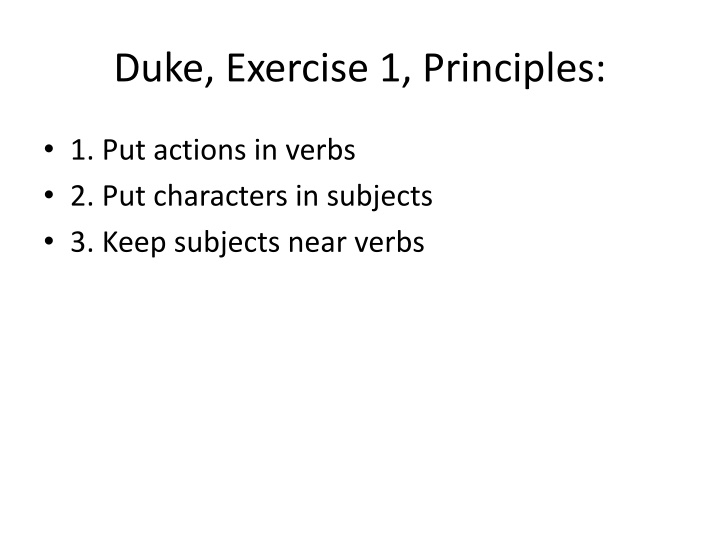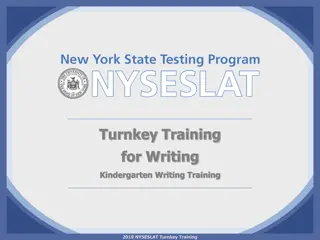Duke Writing Principles and Techniques
Duke provides essential writing principles and techniques to enhance clarity and coherence in your writing. Principles include putting actions in verbs, characters in subjects, and keeping subjects near verbs. Additionally, it emphasizes cohesion, coherence, and emphasis through strategies like putting new information last and using passive voice sparingly.
Download Presentation

Please find below an Image/Link to download the presentation.
The content on the website is provided AS IS for your information and personal use only. It may not be sold, licensed, or shared on other websites without obtaining consent from the author.If you encounter any issues during the download, it is possible that the publisher has removed the file from their server.
You are allowed to download the files provided on this website for personal or commercial use, subject to the condition that they are used lawfully. All files are the property of their respective owners.
The content on the website is provided AS IS for your information and personal use only. It may not be sold, licensed, or shared on other websites without obtaining consent from the author.
E N D
Presentation Transcript
Duke, Exercise 1, Principles: 1. Put actions in verbs 2. Put characters in subjects 3. Keep subjects near verbs
Principle 1: Put actions in verbs We performed an analysis on the data We analyzed the data Verbs should be actions!
Principle 2: Put characters in subjects You can fulfill reader expectations by maintaining a logical flow of grammatical subjects in a paragraph. There are two primary ways to accomplish this: 1. Maintain a common subject throughout a one- topic paragraph (parallel sentence structure) 2. Shift the subject smoothly according to the story
Principle 3: Keep subjects near verbs A sentence tells readers: who and what action The sentence will be straightforward to understand when the subject and verb are close to each other The ABC database has been subject to different improvements, modifications, and extensions in structure and content over the years. The ABC database has been improved, modified, and extended in both structure and content over the years. (passive) The curators have improved the structure and content of the ABC database. (active)
Duke Lesson II: Cohesion, coherence, and emphasis Principle 1: Put new information last Principle 2: Use passive voice rarely Principle 3: Make sure the first and last sentences of a paragraph match (sometimes? I m not sure I like this one) Match the last sentence of the previous paragraph with the first sentence of the next paragraph = more important for smooth transition
Principle 1: Put new information last Most readers will find your writing more clear if you consistently begin sentences with familiar (old) information and conclude sentences with unfamiliar (new) information What happens when you begin a sentence with new information? Your reader gets a new idea without any context. He or she may try (incorrectly) to link this information to the previous sentence. After reading the rest of the sentence, the reader may have to revise his or her understanding. Think of this in the same way as writing your introduction: the very first sentence is something that all of your readers will know Provides readers with something familiar to start the paper
Principle 1: Put new information last Revision technique: Read through your manuscript carefully. In each sentence, underline any pieces of new information (unfamiliar to the reader at this point in the manuscript). Make sure your sentences begin with an appropriate backwards link, and not with an unfamiliar concept. Underlining is a useful tool for many things Go through manuscript, underline noun/verb to make sure they match
Principle 2: Use passive voice rarely Active: The dog chased the ball. Passive: The ball was chased by the dog. Passive: The ball was chased. Active: more straightforward. Subject does an action. US scientists *hate* passive voice. UK scientists rely much more heavily on passive voice. Also avoid excessive use of we (let science be the subject) Let the science be the subject! Editing technique: underline all we ; at most one we per paragraph Underline the noun and verb. Is the verb active? Is the subject noun doing the verb.
When to use passive voice When you want to say something indirectly Sometimes it s more polite Speculation can be passive
Basic premise: be direct and simple (almost) always be direct and simple. Say what you mean
Principle 3: Make sure the first and last sentences of a paragraph match Match adjacent sentences, especially when moving from one paragraph to another.
Duke Lesson 3: Concision and Simplicity Omit needless words (excessive hedging, ineffectual phrases) Prefer simple words Use simple subjects Use adjectives/adverbs frugally (=rarely)
Principle 3: Make sure the first and last sentences of a paragraph match Skipping this one Match adjacent sentences, especially when moving from one paragraph to another.
Duke Lesson 3: Concision and Simplicity Omit needless words (excessive hedging, ineffectual phrases) Prefer simple words Use simple subjects Use adjectives/adverbs frugally
Duke Lesson 3: Concision and Simplicity Omit needless words (excessive hedging, ineffectual phrases) Prefer simple words Use simple subjects Use adjectives/adverbs frugally (=rarely)
Omit needless words Phrases to avoid: Note that It should be noted that Respectively It is important to realize/it is well known So-called
Omit words that stress how good your analysis is! carefully : is it really? If you describe details, I understand the care Figure 3 clearly shows: is it really? If the Figure is clear, you don t need to insist Proven, doubtless These words are red flags for me
Use few adjectives/adverbs Very is very overused Especially for Chinese writers very interesting , very important extremely























